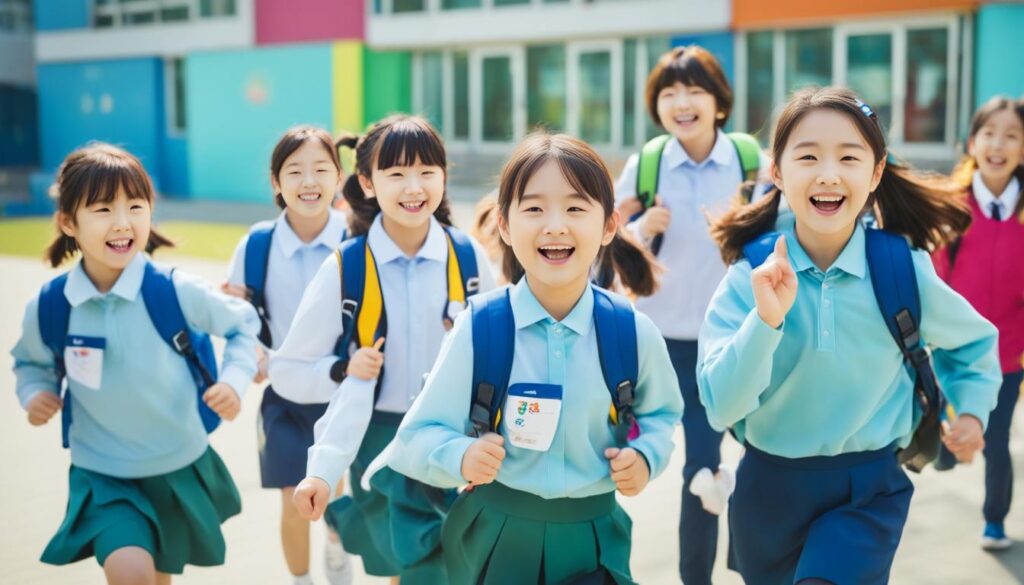As one of the most educated countries in the world, South Korea offers a rich tapestry of educational opportunities for both local and international students. The South Korea education system is known for its rigor, having a profound impact on the lives of students and the nation at large. With an impressive literacy rate of 100%, the significance of education in Seoul—as well as the broader country—cannot be overstated1. This guide examines various aspects of schooling in South Korea, from historical context to current statistics reflecting the state of education and the diverse types of schools available. Whether you are considering studying abroad or simply looking to understand the system more deeply, this guide is your comprehensive resource. For more information on studying abroad in South Korea, you can read this informative article here2.
Key Takeaways
- The South Korean education system emphasizes academic excellence, reflected in an extensive school day.
- Compulsory education lasts nine years, consisting of primary and middle school.
- South Korea has a high enrollment rate of 99.9% in primary education.
- International programs and schools provide unique opportunities for international students.
- Significant resources are allocated to education, with continuous updates to the national curriculum.
- Students engage in extensive private tutoring, particularly at after-school academies known as hagwons.
The Importance of Education in South Korea
Education holds immense value in South Korea, seen as a vital pathway for personal fulfillment and social advancement. The government allocates nearly 4% of the country’s GDP to the educational sector, underscoring its commitment to maintaining high educational standards across all levels3. The historical context of education in Korea reflects foundational Confucian values, which emphasize respect for knowledge, teachers, and the pursuit of academic excellence. This cultural backdrop has led to a robust education system characterized by innovation and reform.
Historical Context of Education in Korea
Historically, the educational landscape in Korea has evolved significantly, moving from traditional Confucian education to a more formalized structure. This transition facilitated major advancements in educational achievements. With high rankings in international assessments like PISA and TIMSS, South Korean students consistently outshine their peers across subjects such as reading, mathematics, and science, thereby emphasizing the importance of education in Korea4. Such accomplishments can be attributed to the structured education system that includes stages from preschool to tertiary institutions.
Current Literacy Rates and Educational Achievements
South Korea today boasts one of the highest literacy rates globally, nearly reaching 100%3. The nation’s emphasis on STEM education prepares students for an increasingly technology-driven world. As South Korean universities gain international recognition for their research output, they play a significant role in attracting foreign students—highlighting the educational achievements that continue to draw global attention. Notably, the existence of hagwons, or private tutoring centers, illustrates the cultural emphasis placed on supplementary education, further enhancing literacy rates in South Korea3.
Overview of the South Korea Education System

The South Korea education system structure has developed into a highly organized and competitive framework. Korean students experience a comprehensive educational path that begins with elementary school and extends through higher education. This system emphasizes academic achievement and standard testing, shaping the careers of millions of students.
Structure of the Education System: 6-3-3-4
The education structure follows a model known as 6-3-3-4. This includes six years of primary education, three years of middle school, and three years of high school, culminating in four years of university or tertiary education. Primary education in South Korea begins at age 6, with children attending school until they reach age 12, followed by middle school until approximately age 15 and high school until age 185. The school year consists of two semesters, offering a rigorous curriculum that emphasizes both theory and memorization, which sometimes limits creative thinking6.
Compulsory Education and Enrollment Rates
In South Korea, compulsory education lasts for nine years, covering both primary and middle school, which results in nearly 100% enrollment rates for primary education7. Approximately 25% of students from middle school opt for vocational training, focusing on practical skills in areas such as Agriculture and Commerce5. With a steady government investment in education, the curriculum continuously evolves to meet the rising demands of a dynamic society highlighting the focus on enhanced educational. Students participate in the College Scholastic Ability Test, which plays a significant role in their educational journey, ensuring that academic standards remain high5. Unfortunately, this creates immense pressure, leading many students to seek additional help through private tutoring, which represents about ten percent of household income7. As a result, this system not only reflects a commitment to education but also showcases the societal challenges tied to academic excellence in South Korea.
School in South Korea: A Look at Different Types

The educational landscape in South Korea is diverse and structured to cater to a wide range of student needs. This section explores the various types of schools available, focusing on primary schools in South Korea, the dynamics of middle schools and high schools, and the provisions for special education in Korea.
Primary Schools and Curriculum Highlights
Primary schools in South Korea provide free and compulsory education, emphasizing essential knowledge and skills. The curriculum integrates critical subjects, with a substantial focus on English language learning, setting a solid foundation for further education. Teachers typically follow a structured schedule, with elementary classes lasting around 40 minutes each8. The supportive environment promotes not only academic growth but also the overall wellbeing of students.
Understanding Middle Schools and High School Choices
As students progress, they transition into middle schools and high schools, where various educational paths are available. Options include general high schools, vocational schools, and special-purpose institutions, reflecting the diverse interests and strengths of students. The competitive nature of education in South Korea means that many students also participate in private classes outside regular school hours to enhance their academic skills. Middle schools and high schools feature a 7:1 student to faculty ratio, which allows for personalized attention9. With 26 Advanced Placement (AP) courses available, students can also pursue more challenging academic opportunities within their high school curriculum9.
Special Education Provisions
The framework for special education in Korea ensures that students with disabilities receive the support they need. Inclusive education practices are in place to facilitate learning in diverse settings. Dedicated student support staff, including counselors and special educators, help to cater to individual needs9. With a focus on creating an equitable educational environment, schools strive to integrate all students and promote their academic and social development.
International Schools and Language Programs
For expatriates and Korean families alike, international schools in South Korea provide a vital educational option that aligns with various Western curricula. These institutions typically emphasize a comprehensive international education while also promoting understanding and appreciation of Korean culture. With an increasing number of families seeking quality education, there are currently 44 international schools spread across the country, with Seoul hosting the highest concentration of 22 schools10. Tuition fees vary widely; for the average international school in Seoul, families can expect to pay between $20,000 to $35,000 annually11.
What to Expect at International Schools
When enrolling in international schools, parents should pay close attention to the curriculum offered, as many schools follow the American, British, or International Baccalaureate programs. In addition to a competitive academic environment, these schools frequently boast impressive university acceptance rates, averaging around 99%12. Furthermore, they usually require students to possess a foreign passport or proof of prior schooling abroad, allowing for a diverse yet focused learning atmosphere ideal for expat families10.
Korean Language Schools: Benefits and Offerings
Korean language schools cater not only to beginners but also to advanced learners who wish to deepen their understanding of the language and culture. Offering conversational courses and immersive experiences, these schools play a crucial role in assisting foreign students in their adjustment to life in South Korea. Benefits include accelerated language acquisition and enhanced cultural engagement, all of which help students integrate into Korean society enquanto studying Korean becomes a fun and engaging experience11.
FAQ
What is the structure of the South Korean education system?
Are international schools in South Korea beneficial for expatriates?
How does the South Korean government support education?
What are the common types of schools in South Korea?
What role does English language learning play in primary education?
What options are available for special education in South Korea?
What advantages do Korean language schools offer?
How important is education in South Korean culture?
Where can I find the top universities in South Korea?
Source Links
- http://koreaneducentreinuk.org/en/education-in-korea/
- https://www.internations.org/south-korea-expats/guide/education
- https://medium.com/@heylearnkoreanwithus/south-koreas-education-system-5019bbe1b5bc
- http://www.koreaneducentreinuk.org/wp-content/uploads/downloads/Education_the-driving-force-for-the-development-of-Korea.pdf
- https://www.scholaro.com/db/Countries/South-Korea/Education-System
- https://additioapp.com/en/the-5-keys-of-south-koreas-education-system/
- https://www.freiheit.org/north-and-south-korea/tough-schools
- https://www.ciee.org/go-abroad/work/teach-english-abroad/blog/whats-it-teaching-english-public-school-south-korea
- https://www.kis.or.kr/
- https://www.schoolinginkorea.org/international-schools
- https://internationalschoolsinkorea.com/blog/best-international-schools-korea/
- http://expatschoolskorea.com/listing/top-international-schools-in-korea

Comments